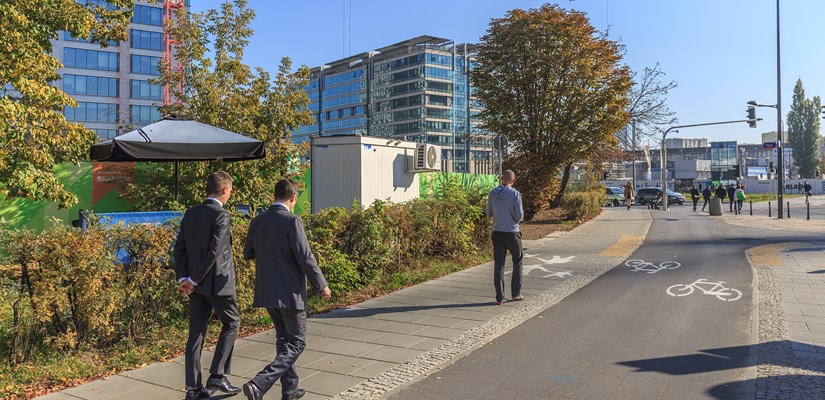
The concrete, tested at the Skanska site, is designed to actively fight city air pollution. How? The latest scientific solutions allow for the concrete to have photocatalytic properties. With the help of the sun's rays, this concrete can reduce harmful compounds from car exhausts (including nitrogen dioxide). These compounds are broken down into harmless substances, similar to those used for fertilizing plants which can then be deposited into the soil via precipitation. An additional advantage of the concrete is that it has self-cleaning properties.
- This innovative product can become a very effective tool in the fight for cleaner air and a better quality of life in the city. We saw how well it performs in Western Europe, which is why we were so keen for it to serve the residents of Warsaw. Activities related to the reduction of environmental impact are permanently embedded in our sustainable development strategy, which is why we have managed to create the appropriate ecosystem for this project's implementation. Without the ecological and social sensitivity of our partner, Skanska, we would not have been able to implement this unique project - says Przemysław Malinowski, Manager of Special Products from the Górażdże Group.
During tests in the 350 sqm. of pavement area, data was collected from special measuring stations. At the same time, the level of air pollution in the area, where there was no environmentally friendly concrete, was also examined. The measurements, carried out jointly by Skanska and renowned scientific units, proved that the area where green concrete had been installed showed a 30% lower concentration of nitrogen dioxide in relation to the normal surface section. Thanks to this research, it is also known that when compact buildings are built next to the Daszyńskiego Roundabout, green concrete will achieve even better results in the fight against Warsaw's smog. In laboratory conditions NOx a reduction of up to 70% was measured. In the Generation Park project, Skanska will install a permanent measuring station that will continuously examine the concentration of air pollutants in the vicinity.
Around Generation Park there will ultimately be laid an area of environmentally friendly concrete roughly the size of a soccer pitch. This area should annually neutralise nitrogen oxides that are the equivalent of exhaust fumes from ten diesel cars that have been driven for at least 17 000 kilometres.
- As a leader in sustainability in the construction industry, we develop and test innovative, green solutions that have a real impact on improving the functioning of cities. We develop office projects in city centers, near major communication arteries - just like the Generation Park office building. For this reason, we have paid particular attention to the problem of urban smog, which is mainly related to car traffic. Thanks to our cooperation with Górażdże Cement S.A. as well as research centers and the application of green concrete technology, we have an opportunity to improve air conditions around our buildings and create somewhat of a green oasis on the smog map of Warsaw. It is also a great example of business and science cooperation – says Anna Tryfon-Bojarska, Innovation Manager in Skanska.
- CSR is also connected to surroundings and the environment in which we build. To the number of "green" technologies from which Skanska is known, we are adding technological advanced materials that will make our lives better in a cleaner and more friendly environment. Concrete which is known for thousands of years as a construction material can also affect the quality of air we breathe by reducing the level of harmful gases that form smog. The first application of this kind of concrete in CEE region in the commercial project will be developed as a part of the Generation Park investment at Daszyńskiego roundabout in Warsaw - says Rafał Stoparczyk, project manager at Skanska Property Poland.
This „green concrete” is a unique product that cleans the air of harmful compounds and has self-cleaning properties. Laboratory tests carried out by Skanska and scientific partners showed that its properties do not alter over time. The test samples were analyzed for the efficiency of NOx reduction as well as the structure at the molecular level.
The partners of the project are Skanska and Górażdże Cement SA and the scientific units involved were the Institute of Geophysics PAN (Polish Academy of Sciences), the Faculty of Civil Engineering at the Warsaw University of Technology and the Faculty of Geology at the University of Warsaw.
This green concrete is a technology that has a chance to become a standard on Skanska's construction sites, significantly improving air quality around the vicinity of office complexes in city centers, which are also working and meeting places. Today's technology also allows the use of self-cleaning concrete on the facades of office, residential and administrative buildings. Ultimately, this green innovation, which is undergoing tests is to be implemented on all new Skanska projects in the CEE region, where there is an issue regarding air quality associated with summer smog.